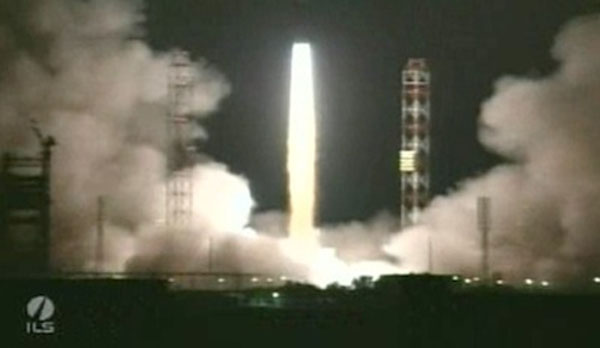Russian Proton Rocket Orbits Two New Broadcasting Satellites

Communications satellites for North America and Kazakhstan blasted off on top of a Proton rocket Friday, beginning a lengthy nine-hour journey to orbit that includes a series of six firings of the rocket's Breeze upper stage engine.
The 191-foot-tall Proton booster rocketed away from the Baikonur Cosmodrome at 2316 GMT (7:16 p.m. EDT), trailing a flickering blue flame from six first stage main engines generating 2.5 million pounds of thrust.
The first stage propelled the rocket into the upper atmosphere just before sunrise, then the Proton's second and third stages finished their burns in less than 10 minutes. The rocket's Breeze M upper stage ignited a few minutes later to inject the SES 3 and Kazsat 2 satellites in a stable parking orbit, according to International Launch Services, the U.S.-based firm overseeing commercial sales of the Proton.
Five more burns of the Breeze M's hydrazine-fueled engine will raise the altitude of the rocket and move it closer to the equator. [Spaceflight Now Photos: Proton Rocket Moves to Launch Pad]
The Breeze stage will release the SES 3 spacecraft at 0717 GMT (3:17 a.m. EDT) Saturday, then fire its engine once more before deploying Kazsat 2 at 0840 GMT (4:40 a.m. EDT).
Kazsat 2 rode on the lower section of the dual-satellite stack. SES 3 was located in the upper position inside the Proton's payload fairing.
Friday's Proton flight is the first time International Launch Services has paired a commercial satellite with another payload on the same mission. Previous Proton launches have placed multiple Russian government satellites into orbit on the same flight.
Get the Space.com Newsletter
Breaking space news, the latest updates on rocket launches, skywatching events and more!
ILS says the twin-satellite arrangement will lower launch costs and make the Proton more competitive for medium-class commercial spacecraft.
SES 3 will be placed in an elliptical geosynchronous transfer orbit stretching from about 2,300 miles to more than 22,300 miles in altitude, with an inclination of 24.7 degrees.
The final Breeze M burn will put Kazsat 2 in a circular 22,000-mile-high orbit over the equator.
The launch is the second Proton mission of the year, but the rocket has a busy manifest of commercial, government and military missions planned for the rest of 2011.
Built by Orbital Sciences Corp. of Virginia, SES 3 is beginning a 15-year mission to deliver educational, international and high-definition programming across the United States and the Caribbean for SES World Skies. It's the second of three similar spacecraft launched for SES World Skies, following a Proton flight with SES 1 last year and the planned launch of SES 2 on an Ariane 5 rocket in August or September.
SES 3 will replace the aging AMC 1 spacecraft launched on an Atlas 2A rocket in 1996. After a series of thruster firings to guide itself to its final orbital post, SES 3 will begin service from 103 degrees west longitude.
The craft's communications payload includes 24 C-band and 24 Ku-band transponders for traditional television broadcast programming and mobile data transmission, broadband Internet and private networks, according to SES World Skies.
The 6,860-pound SES 3 satellite will also unfurl its solar panels and two 7.5-foot antenna reflectors before commencing operations.
Kazsat 2 is destined for a 12-year mission to beam television broadcasts across Kazakhstan and Central Asia.
Owned by the government of Kazakhstan, Kazsat 2 was manufactured by Khrunichev and carries communications instruments built by Thales Alenia Space. The payload consists of 20 Ku-band transponders.
Khrunichev also provided a control center and ground station under the agreement to construct Kazsat 2.
Kazsat 2, which weighed 2,800 pounds at launch, will be parked in geosynchronous orbit at 86.5 degrees east longitude.
Kazakh prime minister Karim Massimov attended the launch with other senior government officials. Russian and Kazakh leaders planned talks on further space cooperation following the launch.
Copyright 2011 SpaceflightNow.com, all rights reserved.
Join our Space Forums to keep talking space on the latest missions, night sky and more! And if you have a news tip, correction or comment, let us know at: community@space.com.
Stephen Clark is the Editor of Spaceflight Now, a web-based publication dedicated to covering rocket launches, human spaceflight and exploration. He joined the Spaceflight Now team in 2009 and previously wrote as a senior reporter with the Daily Texan. You can follow Stephen's latest project at SpaceflightNow.com and on Twitter.










